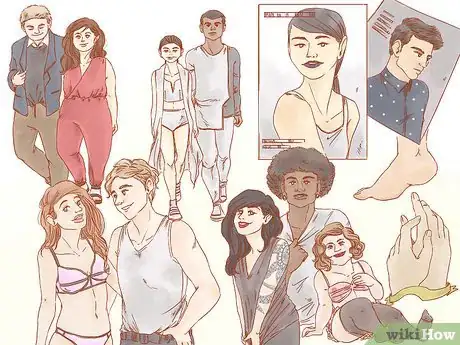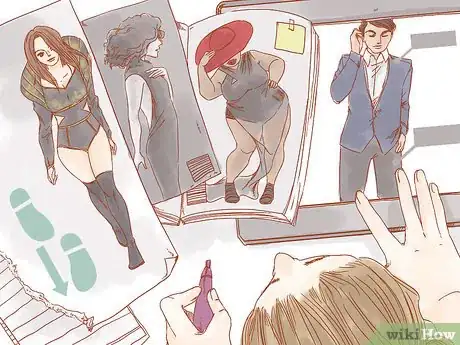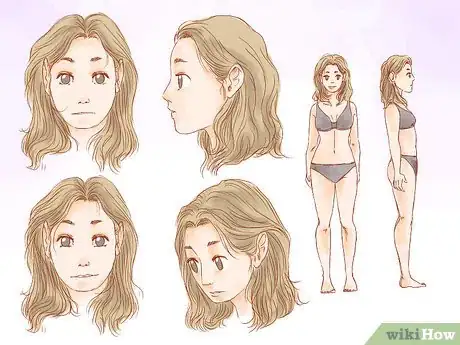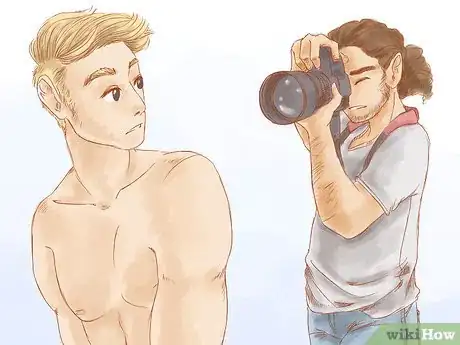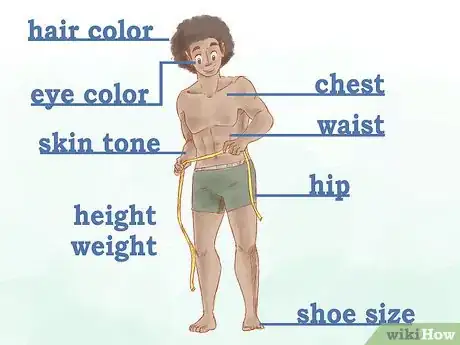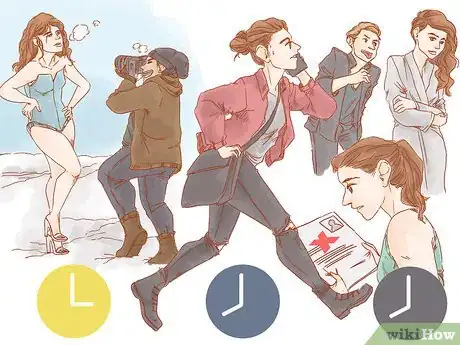This article was co-authored by Traci Halvorson. Traci Halvorson is a Modeling Agent, Former Model, and the Owner of Halvorson Model Management (HMM) in San Jose, California. HMM is a full-service, licensed talent agency representing over 300 professional models and actors. With over 25 years of experience in the modeling industry, Traci specializes in scouting, managing, advising, and launching modeling careers in the Bay Area. Traci holds a BA in Public Relations & Business Management from San Jose State University and also specializes in Marketing, Image consulting, and is a certified Life-Career Coach.
There are 12 references cited in this article, which can be found at the bottom of the page.
wikiHow marks an article as reader-approved once it receives enough positive feedback. This article received 54 testimonials and 98% of readers who voted found it helpful, earning it our reader-approved status.
This article has been viewed 4,954,075 times.
A lot of people want to be a model because it's glamorous and lucrative. They may want to be recognized in the modelling world. Modelling is extremely competitive, and the industry is filled with rejection, but successful models spend their time doing something that they love. Knowing what to expect when entering the world of modeling can help prepare you to become a model.
Steps
Mastering the Basics of Modelling
-
1Be healthy inside. Eat and drink healthy foods and get plenty of exercise. Having a healthy body will help you look your best.
- Fitness is important. Consider working with a trainer who works specifically with models. Tell him about your modeling goals and how you want to look, and ask for a tailored exercise regimen that will support those goals.
- Eat right. Contrary to what some people tell you, you should eat healthy foods, as well as healthy amounts of food. Veggies, fruits, whole grains, healthy fats, and proteins should make up the basics of your diet. Sugars, starches, empty carbohydrates, and unhealthy fats should be avoided as much as possible.
- Be sure to drink a lot of water. Avoid sodas (even diet sodas) and minimize your alcohol intake.[1]
-
2Maintain your appearance. Take care to make yourself look healthy and well-groomed. What you wear and how you carry yourself are important as well, but you should have a routine that supports the health of your skin and hair.[2]
- Focus on keeping your skin clear and glowing. Wash your face in the morning and at night, exfoliate once a week, and remember to wash your makeup off before you go to sleep.
- Keep your hair shiny and healthy. Some agencies and managers prefer the "natural greasy look," so it may be okay if you prefer to minimally shower.
Advertisement -
3Match your modeling goals to your body type. Technically, anybody can be a model. However, if you don't meet certain requirements, the work available to you will be incredibly limited or you may have to compensate in other areas (reliability, technique, etc).
- A Plus-Sized Model: If your body is full and curvaceous, you may be able to be a plus size model.
- A Runway Model: Most women on the catwalk are at least 5'8 and commonly small-breasted. Men are mostly between 5'11 and 6'2.
- A Print Model: Most editorial female models are at least 5'7, but a beautiful face with great personality are the most important features for print models.
- An Underwear Model: For women, this requires large breasts but small hips. For men, this requires broad shoulders but slim waists.
- An Alternative Model: Some agencies hire alternative models: models who do not conform to the industry “standards” of beauty, height, and weight. Additionally, having a specific passion or cause that you're working towards can help open doors that may be closed due based on a body feature that does not “fit industry standards”.[3]
- Other Types of Modeling: If you don't fit any of the face or body descriptions, perhaps you can be a foot, hair, or hand model.
-
4Consider situational modeling. If you do not think the runway or magazines are the place for you, look into other types of modeling. Companies use models for special events or to promote specific products. There are fewer restrictions on body type and more emphasis on personality for these modeling jobs.
- A Promotional Model: Some companies want their customer base to interact directly with models who are generally attractive with likable personalities to promote their brand. You may see these models in grocery stores, events, or clubs promoting things like food, liquor, or new products.
- A Spokesmodel: Spokesmodels are hired to be consistently associated with a specific brand. Contrary to popular thought, spokesmodels don't always have to verbally promote the brand.
- A Trade Show Model: This type of model is hired by companies or brands to advertise to attendees at a trade show tent or booth. These models are typically not employed by the company but hired as "freelance" models for the event.
-
5Consider your "look." The look that you communicate can be made up of both your body type and your style. There is more of a curvy California look, a svelte and sophisticated New York look, a waif-like European look, and a boy- or girl-next-door look. Know what you're equipped with, but also try to pull off other looks.
-
6Educate yourself about the industry. Learn as much as you can from reading books, blogs, and articles about modeling.[4] [5] Reading quality guides, articles, and books will help you improve important skills (like posing and posture) and better understand how the industry works (such as how to find an agent).
- Also research reputable agencies that place models in high-profile places, such as magazines and fashion shows.[6]
-
7Be prepared for a difficult road. The modeling world is jam-packed with pretty faces. Being good looking does not equate to success as a model. The modeling business is not just about looking great; you have to fit the need of specific jobs just in order to get a chance. Modeling is only for serious people who carry unique looks and characteristics. Since there are so many people trying to become models in today's world, it's very challenging to get into the industry. Success will only come with patience and perseverance.
-
8Do not be shy. You will have to promote yourself and look for opportunities to step up and prove your abilities. Standing back and being “polite” will not get you where you are going. Be yourself, let your personality shine, and have a confident attitude.[7] If you don't feel confident, fake it; modeling often requires acting skill as well!
Understanding Portfolios and Agencies
-
1Take photographs for your portfolio. You should include professional-looking headshots: shots of you up close without a lot of makeup and on a plain background. You should shoot them in nice natural light (but not direct sunlight) without a lot of distraction in the photos. These are meant for agencies to get a look at you in a raw state. Consider a head shot, a body shot, and profile shots.
- The most important thing to communicate in a portfolio is that you are able to present a range of “characters” and looks.
-
2Consider getting some professional photos taken. Though professional photography can be expensive, it can make the difference between being passed over and getting an interview. Think of professional photography as a worthwhile investment in your career![8]
- Get your favorite professional shots printed into 8x10s. Save these in case you are asked to leave a photograph before or after an interview.
- If you've got enough good professional photos, consider compiling them into a portfolio. Bring this portfolio with you to castings or agencies.
-
3Take your measurements and know your stats. This information can help modeling agencies place you.[9] Knowing the information off the top of your head will help you seem professional when you are speaking with an agency or potential client.
- The most basic measurements to know are your height, weight, and shoe size.
- You should also know your clothing measurements such as dress size, hip, waist, chest/bust, etc.
- Your personal stats include information such as hair color, eye color, and skin tone.
-
4Visit a modeling agency. Almost every major city has multiple modeling agencies, and almost every agency has "open-calls" where they look for new talent.[10]
- Bring your photographs and/or portfolio. Be sure to have your (accurate) measurements as well.
- You may be asked to walk or pose for a headshot or other photos during an open call interview.
- If an agency rejects you, don't get disheartened; often an agency is looking for a diverse set of models, so you may just not fit their model lineup right now.
- Research and send exactly what the agency is asking for. Sometimes, people just send what they want to send, and not what the agency can use.[11]
-
5Be wary of scams. Try to research the reputation of a modeling agency prior to an open call or interview. Too many people don't know about the business and end up getting conned. [12]
- No agency should be asking you for more than $20 when meeting you. The agency will charge you a commission when you model, but shouldn't get much up front. If they ask for hundreds of dollars from you before you do any work, walk away.
-
1Do not sign consent forms without consulting your agent. A client may ask you to sign paperwork or consent forms. Before you sign, be sure to ask for a copy to share with your agent. You do not want to sign a form that gives a photographer or client more power over your actions or images than they should have.
- Similarly, do not sign a contract with an agency unless the agency and the contract both seem legitimate. If you are not sure whether the contract is good, have an attorney or an experienced model read over it for you.[13]
- A good agent should have your best interests in mind. She should help you navigate the legal issues in any given contract. [14]
-
2Be truthful about your measurements. Don't say you're skinnier than you are just to get a shoot. Once there, the stylist will have problems fitting you and the truth will come out. You could potentially lose future jobs due to word of mouth, and you could find yourself without a career!
-
3Be professional, polite, and courteous. Remember that, even though you're not working in an office, you need to be professional.[15] [16] Treat the people you work with respectfully. You never know who they know or what sort of a recommendation they might give of you. Never look down on anyone. You may be a model, but that doesn't give you the right to be snooty, affected, or pompous.
- Always show up on time to any appointment or shoot. If you're late or rude, your reputation may precede you and nobody will want to work with you.
- Be organized. Models often get called to places at the last minute and have very busy days. You need to be on top of things if you want to succeed. Buying a day-to-day planner can really help.
- Develop professional relationships with photographers. You help the photographer look great, and they will help you look great. It's a win-win situation, so be sure to treat photographers with respect.
-
4Treat modeling like a real job. Individuals who don't take it seriously have small chances of succeeding in their modeling career.[17] Realize that it is harder than it appears and there's a lot of work behind all the glitz and glamour you see at fashion shows. Modeling is a full time occupation that requires constant attention. One week away from it and your career can be over.
- Understand that modeling has only a small window of opportunity, and even if you take a short break, you may never be able to return. Models usually only work in the business for a limited amount of time. If you become famous inside of the business, you may be able to extend your career.
-
5Confirm whether or not there will be a make-up artist (MUA) on site. Sometimes you are expected to bring certain things with you (such as base foundation) and if they don't have a makeup artist booked, you need to prepare accordingly. You may want to keep an emergency makeup kit with you so that you can do your own makeup if necessary, even if a MUA is supposed to be present.[18]
-
6Be creative on the job. Photographers want to see you pose in various poses with different props and backdrop. Changeability is key, so work for the camera and interact with the world around yourself[19] Listen to the photographer's recommendations, but don't be afraid to try your own poses or attitude as well. Similarly, runway coordinators want you to put attitude in your walk or to project a very specific emotion.
Expert Q&A
-
QuestionHow do you get noticed?
 Traci HalvorsonTraci Halvorson is a Modeling Agent, Former Model, and the Owner of Halvorson Model Management (HMM) in San Jose, California. HMM is a full-service, licensed talent agency representing over 300 professional models and actors. With over 25 years of experience in the modeling industry, Traci specializes in scouting, managing, advising, and launching modeling careers in the Bay Area. Traci holds a BA in Public Relations & Business Management from San Jose State University and also specializes in Marketing, Image consulting, and is a certified Life-Career Coach.
Traci HalvorsonTraci Halvorson is a Modeling Agent, Former Model, and the Owner of Halvorson Model Management (HMM) in San Jose, California. HMM is a full-service, licensed talent agency representing over 300 professional models and actors. With over 25 years of experience in the modeling industry, Traci specializes in scouting, managing, advising, and launching modeling careers in the Bay Area. Traci holds a BA in Public Relations & Business Management from San Jose State University and also specializes in Marketing, Image consulting, and is a certified Life-Career Coach.
Modeling Agent Send quality information about yourself, look like a professional, do your research, and send exactly what the agency is looking for. Unfortunately, some people send what they want to send, and not what agencies can use.
Send quality information about yourself, look like a professional, do your research, and send exactly what the agency is looking for. Unfortunately, some people send what they want to send, and not what agencies can use. -
QuestionHow do I submit to be a model?
 Traci HalvorsonTraci Halvorson is a Modeling Agent, Former Model, and the Owner of Halvorson Model Management (HMM) in San Jose, California. HMM is a full-service, licensed talent agency representing over 300 professional models and actors. With over 25 years of experience in the modeling industry, Traci specializes in scouting, managing, advising, and launching modeling careers in the Bay Area. Traci holds a BA in Public Relations & Business Management from San Jose State University and also specializes in Marketing, Image consulting, and is a certified Life-Career Coach.
Traci HalvorsonTraci Halvorson is a Modeling Agent, Former Model, and the Owner of Halvorson Model Management (HMM) in San Jose, California. HMM is a full-service, licensed talent agency representing over 300 professional models and actors. With over 25 years of experience in the modeling industry, Traci specializes in scouting, managing, advising, and launching modeling careers in the Bay Area. Traci holds a BA in Public Relations & Business Management from San Jose State University and also specializes in Marketing, Image consulting, and is a certified Life-Career Coach.
Modeling Agent Some agencies no longer hold open calls and only screen through emails. For instance, all of Los Angeles modeling is done through online submissions.
Some agencies no longer hold open calls and only screen through emails. For instance, all of Los Angeles modeling is done through online submissions. -
QuestionHow can you become a model with no experience?
 Traci HalvorsonTraci Halvorson is a Modeling Agent, Former Model, and the Owner of Halvorson Model Management (HMM) in San Jose, California. HMM is a full-service, licensed talent agency representing over 300 professional models and actors. With over 25 years of experience in the modeling industry, Traci specializes in scouting, managing, advising, and launching modeling careers in the Bay Area. Traci holds a BA in Public Relations & Business Management from San Jose State University and also specializes in Marketing, Image consulting, and is a certified Life-Career Coach.
Traci HalvorsonTraci Halvorson is a Modeling Agent, Former Model, and the Owner of Halvorson Model Management (HMM) in San Jose, California. HMM is a full-service, licensed talent agency representing over 300 professional models and actors. With over 25 years of experience in the modeling industry, Traci specializes in scouting, managing, advising, and launching modeling careers in the Bay Area. Traci holds a BA in Public Relations & Business Management from San Jose State University and also specializes in Marketing, Image consulting, and is a certified Life-Career Coach.
Modeling Agent Do your research, plan accordingly, and take advice as you go. Sometimes, people are fed the wrong information, which leads down the wrong path. It all comes down to researching, knowing what you're doing, and knowing how to put yourself out there.
Do your research, plan accordingly, and take advice as you go. Sometimes, people are fed the wrong information, which leads down the wrong path. It all comes down to researching, knowing what you're doing, and knowing how to put yourself out there.
Warnings
- If you are invited to a foreign country for an audition or job, have enough funds to purchase a return ticket yourself. While legitimate overseas jobs exist, there are many scams that provide one way tickets then trap young girls into prostitution rings when they cannot afford to go back home.⧼thumbs_response⧽
- The pressure of modeling can cause a lot of long term mental health problems, including eating disorders. Don't be afraid to speak to somebody if you think it is getting all too much. If you just can't handle the pressure, it may be time to start thinking of a new profession. A job isn't worth your health!⧼thumbs_response⧽
- Almost all agencies will ask you to fill out a contract. Be sure to read through it thoroughly and make sure you know what every word means. Ask a seasoned model or an attorney to check the paperwork if you do not understand it. It is better know what you are signing for before you accept.⧼thumbs_response⧽
- If you are planning a photo shoot with a photographer you have met online, it is highly recommended that you bring a chaperone to the shoot. It's for your own safety, as you never know who is who online! If you can't bring a chaperone (because you are unable to find one or because the photographer doesn't allow chaperones), make sure you do a background search on the photographer first- check out things such as who they have worked with and for - and call somebody when you get to the shoot and when you leave the shoot.⧼thumbs_response⧽
- Be very careful of the studio that you go to, they might look like a real professional company. Then you might pay a lot of money and it could end up being a scam.⧼thumbs_response⧽
- Be wary of any agency that asks for money up front. The majority of agencies get their money through commission, meaning they take a certain percentage of your pay for every job that you do. If you don't work, then they don't get paid. If you've already paid up, there's no incentive for them to find you work. However, don't dismiss everybody who asks you for up-front fees as a scam.[21] Some agencies require you to go through professional training before sending you out to represent their brand. Skills like walking in heels and with other models is much harder than it may appear. Also, depending on the agency, training will teach you communicate clearly, confidently, and think creatively on demand without allowing anxiety or nervousness to affect your performance. If you're unsure about an agency, ask other models they represent what they think of the representation and training they are getting. Do you really expect to walk into a professional industry without any experience or knowledge how what to do? You can, but your chances of success will suffer if you're not well prepared.⧼thumbs_response⧽
- Modeling scams are very real and very easy to fall victim to. They play off the hopes and dreams of the innocent. Be careful who you trust.[22]⧼thumbs_response⧽
References
- ↑ http://www.modelmanagement.com/modeling-advice/modeling-tips/
- ↑ http://www.modelmanagement.com/modeling-advice/modeling-tips/
- ↑ http://www.huffingtonpost.com/summer-rayne-oakes/modeling-industry_b_3287289.html
- ↑ http://www.marieclaire.com/fashion/advice/g740/how-to-model/?slide=1
- ↑ Traci Halvorson. Modeling Agent. Expert Interview. 17 June 2021.
- ↑ http://www.marieclaire.com/fashion/advice/g740/how-to-model/?slide=1
- ↑ http://www.marieclaire.com/fashion/advice/g740/how-to-model/?slide=6
- ↑ http://www.marieclaire.com/fashion/advice/g740/how-to-model/?slide=3
- ↑ http://www.modelmayhem.com/education/modeling/8375-how-to-take-proper-measurements-for-your-modeling-profile
- ↑ http://www.modelmanagement.com/modeling-advice/modeling-tips/
- ↑ Traci Halvorson. Modeling Agent. Expert Interview. 17 June 2021.
- ↑ https://www.consumer.ftc.gov/articles/0071-look-out-modeling-scams
- ↑ http://www.marieclaire.com/fashion/advice/g740/how-to-model/?slide=7
- ↑ http://www.marieclaire.com/fashion/advice/g740/how-to-model/?slide=7
- ↑ http://www.modelmanagement.com/modeling-advice/modeling-tips/
- ↑ Traci Halvorson. Modeling Agent. Expert Interview. 17 June 2021.
- ↑ Traci Halvorson. Modeling Agent. Expert Interview. 17 June 2021.
- ↑ http://www.modelmayhem.com/education/style-makeup/1381-how-to-be-your-own-makeup-artist
- ↑ http://www.seventeen.com/fashion/news/a16797/tyra-banks-modeling-tips/
- ↑ http://www.modelmayhem.com/education/modeling/6279-intro-to-freelance-modeling
- ↑ https://www.consumer.ftc.gov/articles/0071-look-out-modeling-scams
- ↑ https://www.consumer.ftc.gov/articles/0071-look-out-modeling-scams
About This Article
To become a model, start by following a fitness, diet, and skincare routine to achieve the ideal body for the type of modeling that you’d like to do. When you’re starting out, have portraits taken for your portfolio, including professional headshots, a body shot, and profile shots. Make sure you keep track of your measurements and clothing sizes to provide agencies with updated information. When you’ve had some professional photos taken, make appointments to discuss signing with a professional agency that will help you find work as a model. To learn more about detecting scams or signing consent forms from our Professional Model co-author, keep reading the article!


